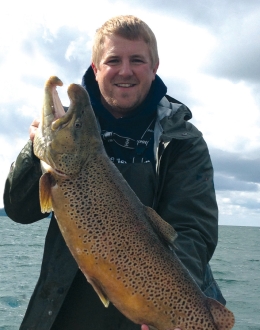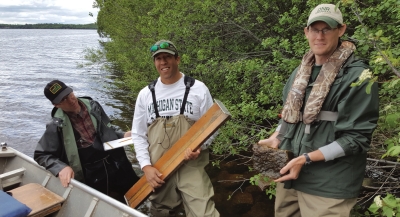Managing Fish Populations in the Great Lakes
- Brian M. Roth
- Associate Professor
- Department of Fisheries and Wildlife
- College of Agriculture and Natural Resources

Willie Fetzer and a large brown trout on Bay de Noc, Lake Michigan.
Brian Roth, associate professor in MSU's Department of Fisheries and Wildlife, is a nonnative species, at least as far as the Great Lakes are concerned. However, he grew up in a watery place (Seattle), and has a lot of childhood memories of fishing excursions to Lake Washington, a large, deep lake that borders Seattle's eastside.
Roth's lifelong interest in lakes and fishing sparked his pursuit of an academic career in fish ecology and a new partnership with the Michigan Department of Natural Resources (MDNR) to study nearshore fish communities in the Great Lakes. The nearshore is a poorly understood component of the lakes.
"The Great Lakes, especially Huron, have undergone dramatic changes in the past 10 years," said Roth. "We've seen the collapse of two species, alewife and salmon, that were major economic drivers for more than 30 years, from the establishment of invasive species."
Roth explained that the alewife, a fish related to the herring family, invaded the upper Great Lakes back around the 1920s from Lake Ontario. "But they had so few predators they became a nuisance," said Roth. "They were dying en masse on beaches." So in the 1960s the MDNR stocked two species of Pacific salmon—Coho and Chinook—in the lakes, hoping that the salmon would keep the alewife population in line as well as offer a new option for recreational fishing.
This plan worked nicely until the 2000s. The salmon ate the alewives, and the fishing community loved the salmon. "Then zebra and quagga mussels came along," said Roth. "We're still trying to figure out why they had such a negative effect on the alewives." The zebra and quagga mussels decreased the food available to the alewives, which was most likely a factor in the collapse of the alewife population in Lake Huron. The Chinook salmon, which depended on the alewives as their food source, soon followed.
With the decline of the offshore fish populations—the alewife and salmon—more attention is being focused on nearshore communities, which had not previously been studied intensively. "That's where I come in," said Roth. "The MDNR does routine fish monitoring across the Great Lakes, but they operate only four Great Lakes field stations, which work somewhat independently based on various practical and logistic issues. My role is to bring these field station datasets together. We don't yet have a good idea how much fish communities differ across the lakes, or whether they are being affected in the same ways by stressors. Cross-lake comparisons will definitely improve our ability to prioritize management actions."
Two of Roth's colleagues at MDNR, Dave Clapp at the Charlevoix field station and Gary Whelan, program manager of the Fisheries Division, agreed that university/agency collaborations add significant value to existing long-term surveys. "Michigan State University researchers have been great partners with the Fisheries Division for many years, and Brian's lab continues in that tradition," said Clapp.
Nearshore data are becoming more important to recreational fisheries for walleye and bass as these populations increase and expand. These nearshore species are taking advantage of another species invasion, the round goby, which provides food for them. The same strategy that worked earlier for the alewife and salmon applies. The walleye and bass eat the gobies, and in turn are caught and consumed themselves—a solution that is fine for now, but as a major shipping area that sees all sorts of fishy "stowaways" arriving all the time, the lakes need constant monitoring for new invaders and constant rebalancing.

Brian Roth (center) with MDNR fisheries biologists Troy Zorn (left) and John Bauman (right). Zorn is heavily involved in the collection and maintenance of MDNR's database on fish in Bay de Noc and an active member of the research team. Bauman works out of MDNR's Escanaba Field Station.
"My project is looking at the field station datasets over time and space," said Roth. "We are beginning to see trends from the analysis. William Fetzer, my former research associate, went to the field stations to discuss their data. He and the MDNR partners did the data analyses. The field stations have a lot of expertise for what they do at their own station. What MSU is able to do is large holistic analyses on underused datasets, put them together quantitatively, and develop new insights for fisheries managers. It is a true joint effort."
Over the past five years Roth's team has found that most places in Lake Michigan are trending toward a suite of fish that are comfortable in warmer water. Fish that tolerate the higher temperatures better also seem to manage pollution such as phosphates better. "It was a surprise," said Roth.
Other lakes are showing more mixed communities of fish based on preferred temperature. "Even Lake Michigan is different between the east coast bays and the open water areas," said Roth. "The lakes all have different fish communities, which is interesting given the pool of species. Yellow perch turns out to be a bay fish. We thought there would be more of them in open water, but they're not."
One bit of good news: The Great Lakes seem to be unique in terms of climate change. "There's so much cold water!" said Roth. "Even with extensive warming there's still a lot of cold water habitat offshore. But we're not always seeing similar fish in similar climates—which raises more questions than it answers. Our developing partnership with MDNR is needed to get more data, interpret trends, and provide new information for fisheries managers. And we're still working on how to integrate this information into management actions. There are a lot of unknowns."
The project with MDNR was a great opportunity. It helped me land my current position. I came from a traditional academic background. To be able to tap into DNR institutional knowledge and observe their discussions prepared me for some of the challenges I now face working for a management agency. In the academy that link is weak. With the MDNR project I learned how things work on the ground and the challenges of working on such a large scale, where multiple jurisdictions work together to manage one resource.
The project continues to help me, largely because of my continuing relationships with MDNR people. They have been helpful in transitioning to my new job. Whenever I need to ask questions I feel comfortable because I already know them. These connections are probably the most beneficial thing that came out of the project for me.
At the beginning of the project, MDNR didn't have a very good sense of what was happening in the nearshore at the broad spatial scale since most analyses focused on a specific area. But it turned out they were actually getting pretty good coverage. MDNR's coverage is amazing. We found very few major knowledge gaps in terms of assessing trends. They also do a great job of maintaining consistent sampling protocols across time. Through these continuous data sets, we can better assess the environmental drivers of fish community change, without the complications of inconsistent survey designs.
This work has great potential for future applications. We sent data from across the state to the UM/MDNR Institute for Fisheries Research in Ann Arbor. Our data will be integrated into data from across the basin. The next step is to look at how environmental conditions interact with ecological perturbations to drive fish productivity and resilience. It will be interesting to see what additional questions this effort can help answer.
William W. Fetzer
Former postdoctoral research associate in Brian Roth's lab
Now a fisheries biologist at Wisconsin Department of Natural Resources
- Written by Linda Chapel Jackson, University Outreach and Engagement
- Photos by Randy Claramunt